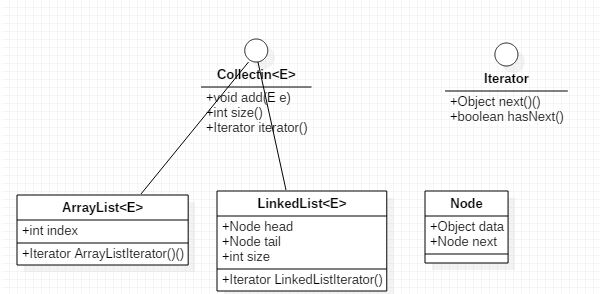设计模式—迭代器Iterator模式
什么是迭代器模式?
让用户通过特定的接口访问容器的数据,不需要了解容器内部的数据结构。
首先我们先模仿集合中ArrayList和LinkedList的实现。一个是基于数组的实现、一个是基于链表的实现,实现方式各有不同,
为了减少代码的耦合度,面向接口编程。定义Collection接口定义API规范。

可是在遍历集合中的元素时,由于数组和链表的遍历方式不一样,能不能统一处理呢?
再定义一个Iterator接口,让每一个子类集合都实现接口中的方法。
1.接口Collection.java
public interface Collection<E> {
public void add(E e);
public int size();
public Iterator iterator();
}
2.接口Iterator.java
public interface Iterator {
public Object next();
public boolean hasNext();
}
3.实现ArrayList.java
public class ArrayList<E> implements Collection<E>{
//先给定一个长度为10的数组
Object [] objects = new Object[10];
//冗余一个int指数,方便判定是组是否为满和返回集合大小
int index = 0;
@Override
//1.动态添加元素
public void add(E e) {
//1.1先判断数组是否已满
if(index == objects.length){
Object [] newObjects = new Object[objects.length*2];
System.arraycopy(objects, 0, newObjects, 0, objects.length);
objects = newObjects; //数组是引用数据类型
}
//1.2为新添加的元素指定下标
objects[index] = e;
//1.3index自加1,以方便返回集合在大小
index++;
}
//2.根据下标访问元素
@Override
//3.返回集合大小
public int size() {
return index;
}
@Override
public Iterator iterator() {
return new ArrayListIterator();
}
private class ArrayListIterator implements Iterator {
private int currentIndex = 0;
@Override
public Object next() {
// 返回最下一个元素
Object o = objects[currentIndex];
currentIndex++;
return o;
}
@Override
public boolean hasNext() {
// 判断是否为最后一个元素
if(currentIndex >= index){
return false;
}
return true;
}
}
}
4.Node.java

public class Node {
private Object data;
private Node next;
public Node(Object data, Node next) {
super();
this.data = data;
this.next = next;
}
public Object getData() {
return data;
}
public void setData(Object data) {
this.data = data;
}
public Node getNext() {
return next;
}
public void setNext(Node next) {
this.next = next;
}
}
5.实现LinkedList.java
public class LinkedList<e> implements Collection<e> {
private Node head;
private Node tail;
private int size;
public void add(E e){
Node n = new Node(e, null);
if(head == null){
head = n;
tail = n;
size++;
} else {
tail.setNext(n);
tail = n;
size++;
}
}
public int size(){
return size;
}
@Override
public Iterator iterator() {
return new LinkedListIterator();
}
private class LinkedListIterator implements Iterator {
private Node currentNode = head;
@Override
public Object next() {
Object o = currentNode.getData();
currentNode = currentNode.getNext();
return o;
}
@Override
public boolean hasNext() {
if(currentNode.getNext() == null){
return false;
}
return true;
}
}
}
在以上的实现可关注:1.ArrayList和LinkedList的不同实现方式
2.Iterator模式的运用
3.实现Iterator时内部类的使用







 浙公网安备 33010602011771号
浙公网安备 33010602011771号